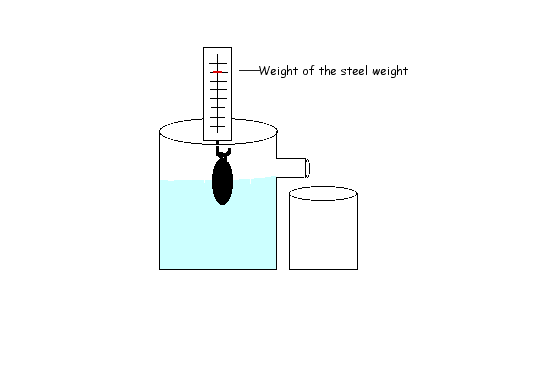Topic outline
-

Outcomes
In this course you will learn about:- Archimedes discovery.
- Why some objects float and others sink.
- Buoyant force.
- Archimedes principle.
-
Archimedes was a talented Greek mathematician whose inventions changed the world. Click here to learn more about Archimedes. He is also famous for a scientific law, called the Archimedes principle, which explains why objects float or sink.
Archimedes was asked by the king of Syracuse to test the purity of gold of his new crown and when the mathematician stepped into his bathtub he discovered what is now known as the Archimedes principle. It is said that he shouted "Eureka" (I have found it) and ran naked through the streets of Syracuse when he discovered what makes objects sink or float.
The story of how the Archimedes principle was discovered is well-known. You can watch the next animation to see how the story came to be.
-
If you place different objects in a bowl of water, for example, coins, pens, erasers and a ball, you will notice that some of the objects float on water, while others sink.
Sink or float?
The three main factors that determine whether an object will float or sink are:
Weight: The weight of an object is measured in newtons and measures the gravitational force acting on that object. Heavy objects sink and lighter objects float on water.
Density: Anything that has mass, including liquids, will have density. Density relates an objects mass to its volume. A heavy object has a higher density than a lighter object. Objects denser than water will sink and objects less dense than water will float.
Buoyancy: Buoyancy is the ability of an object to float on water or other liquid or gas. Buoyant objects float and dense objects sink.
Why are large ships made of steel able to float on water? The reason for this can be explained by what Archimedes noticed when he got into the bathtub. The displacement of water is what keeps ships afloat, we call this the buoyancy effect. For a ship to float on water, it needs to displace its own weight in water. The buoyant force on the boat will counteract gravity's downward pull.
Buoyant Force
Watch the next video to see an experiment that explains the upward force (thrust) exerted on objects placed in water.
NOTE: A floating object is said to be buoyant.-
Activity: Determining densities
Density is an important concept, and has many applications in science and technology.
Density is defined as the amount of mass per volume a substance contains, and it is normally expressed in units of \( g/cm^3\) or \( kg/cm^3\).
Watch the next video for an activity on finding the density of different objects.
-
-
Archimedes principle states that an object submerged in a fluid (any liquid) experiences a force pushing upward called the buoyant force, which is equal to the volume of the fluid that the body displaces. This is also called the law of buoyancy. If an object weighs more than its own volume in fluid, it will sink.
This principle is illustrated in the graphic below.

Archimedes' principle allows the buoyancy of any floating object partially or fully immersed in a fluid to be calculated. Understanding buoyancy is important for finding out how objects behave in a fluid (liquid or gas).
-
Experimenting with Archimedes principle
What you will need:
- Two eggs (or grapes)
- Two glasses of water
- Salt
- A spoon
What you will do:- Place one of the eggs into one of the glasses of water. What do you notice?
- Put a teaspoon of salt into the other glass of water and stir until it dissolves.
- Place the other egg into the salty water. What do you notice and why?
What did you find?- When you place an egg into a normal glass of water it will sink. This is because the egg has a greater density than the water.
- When you put an egg into salty water it floats. The salt increases the density of the water, which makes the buoyancy stronger and makes the egg feel lighter. The egg floats in salty water because the water now has a greater density than the egg.
-
Calculations using Archimedes principle
We can use Archimedes' principle to calculate the volume of an object with an irregular shape. The oddly shaped object can be submerged in water, the volume of the liquid displaced will be equal to the volume of the object.
The formula for Archimedes' principle can also be used to calculate the density or specific gravity of an object.
Watch the next video for examples of how to apply this law.
-